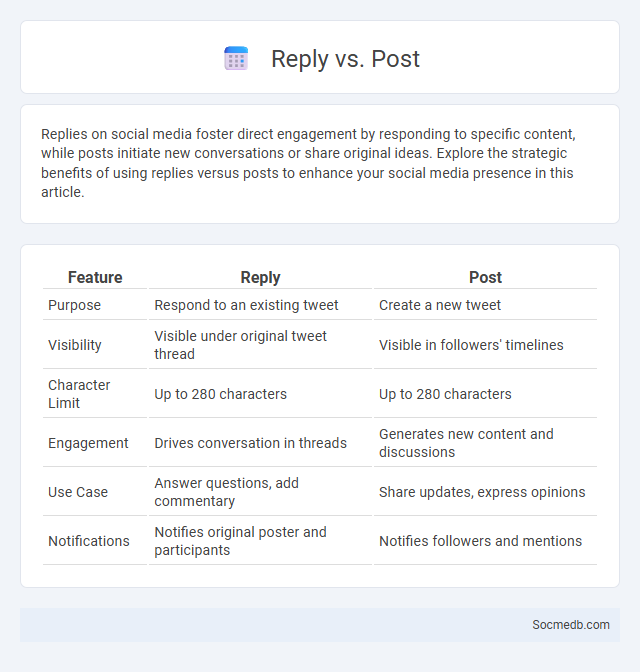
Photo illustration: Reply vs Post
Replies on social media foster direct engagement by responding to specific content, while posts initiate new conversations or share original ideas. Explore the strategic benefits of using replies versus posts to enhance your social media presence in this article.
Table of Comparison
| Feature | Reply | Post |
|---|---|---|
| Purpose | Respond to an existing tweet | Create a new tweet |
| Visibility | Visible under original tweet thread | Visible in followers' timelines |
| Character Limit | Up to 280 characters | Up to 280 characters |
| Engagement | Drives conversation in threads | Generates new content and discussions |
| Use Case | Answer questions, add commentary | Share updates, express opinions |
| Notifications | Notifies original poster and participants | Notifies followers and mentions |
Introduction: Understanding Reply vs Post
Reply and post serve distinct functions on social media platforms, with posts acting as original content shared with your audience and replies serving as responses within conversations. Your ability to craft engaging posts can increase visibility and attract followers, while thoughtful replies foster community interaction and deepen relationships. Mastering the difference between replies and posts enhances your overall social media strategy and communication effectiveness.
Defining 'Post' in Online Communication
A post in online communication refers to content shared on social media platforms like Facebook, Instagram, Twitter, or LinkedIn, comprising text, images, videos, or links. Posts function as digital messages enabling users to express opinions, share information, and engage with audiences in real-time. Effective posts optimize reach and interaction through relevant hashtags, tagging, and compelling captions tailored to target demographics.
What Constitutes a 'Reply'?
A 'reply' on social media constitutes a direct response to a specific post or comment, often linked or nested to maintain conversational context. It typically features the original user's handle or username, ensuring clear attribution and engagement tracking. Replies play a vital role in fostering interactive discussions and enhancing algorithmic relevance within platforms like Twitter, Facebook, and Instagram.
Key Differences: Reply vs Post
A Reply on social media is a direct response to a specific message or comment, creating a threaded conversation visible under the original post. A Post, however, is a standalone message intended for broad visibility on your profile or timeline, serving as the primary content you share. Understanding these key differences helps you engage effectively by choosing whether to join an existing discussion or start a new one.
When to Post vs When to Reply
Posting on social media during peak user activity hours maximizes visibility and engagement, typically between 9 AM to 11 AM and 6 PM to 9 PM depending on the platform. Responding to comments and messages promptly within the first hour significantly boosts interaction rates and strengthens audience relationships. Analyzing audience behavior and platform-specific peak times ensures optimized timing for both posts and replies, enhancing overall social media performance.
Impact on Online Engagement: Post vs Reply
Posts on social media typically generate higher initial visibility and engagement metrics such as likes and shares, establishing primary content streams. Replies, however, drive deeper interactions by fostering conversations and community building, increasing time spent on the platform and enhancing user retention. Analyzing engagement data shows that while posts attract broader attention, replies contribute significantly to sustained user involvement and network effects.
Thread Organization: Role of Posts and Replies
Efficient thread organization in social media enhances user engagement by clearly distinguishing between original posts and subsequent replies. Posts serve as primary content carriers, while replies facilitate focused discussions and maintain conversational flow. Your participation benefits from this structure by making interactions more coherent and easier to follow within dynamic online communities.
Real-World Examples: Reply vs Post Usage
Understanding the difference between replies and posts on social media platforms is crucial for maximizing engagement and audience reach. Posts serve as original content that establishes your presence and initiates conversations, while replies foster direct interactions, creating personalized connections with followers. Your strategic use of replies versus posts can significantly influence the visibility and relational dynamics within your online community.
Best Practices for Posting and Replying
Consistently posting high-quality content tailored to your audience increases engagement and visibility on social media platforms. Timely and thoughtful replies to comments or messages enhance your brand's reputation and foster a loyal community. You should monitor analytics regularly to refine your posting schedule and optimize interaction strategies for maximum impact.
Conclusion: Choosing Between Post and Reply
When deciding between posting and replying on social media, consider your goal: posts are ideal for sharing original content and driving broader engagement, while replies foster direct interaction and build personal connections. Your choice affects visibility, as posts reach wider audiences, whereas replies deepen relationships with specific users. Understanding these differences helps you optimize your social media strategy for maximum impact.
 socmedb.com
socmedb.com